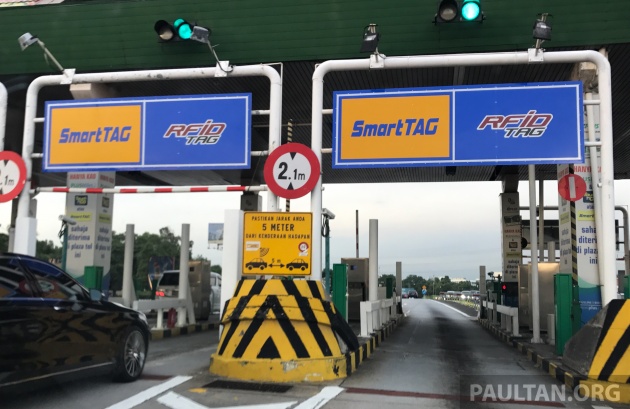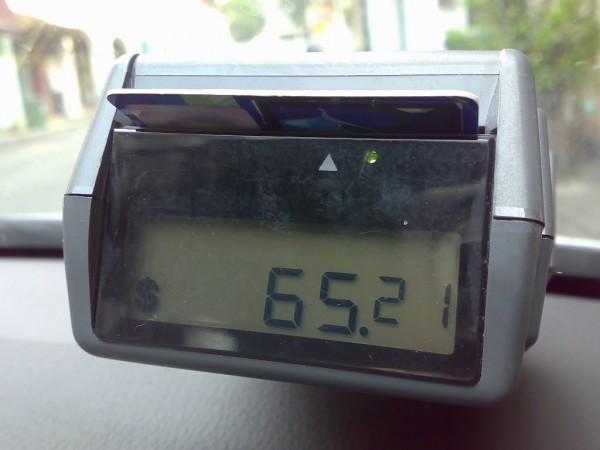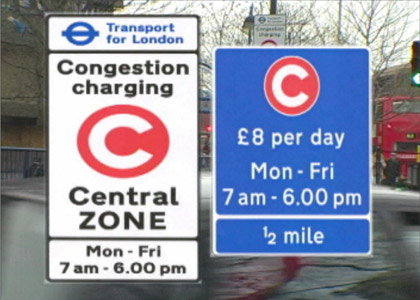Our gomen has epic plans for RFID tags, and its gonna be for more than just tolls

- 432Shares
- Facebook362
- Twitter8
- LinkedIn9
- Email15
- WhatsApp38
Not long ago, the Malaysian Transport Ministry announced that they’ll be implementing a new RFID tag for the Malaysian-Singaporean border. The new RFID tag will replace the existing Vehicle Entry Permit (VEP) tags you use to cross the border, which are currently JPJ issued receipts you display on your dashboards as proof of registration.
RFID stands for Radio-Frequency IDentification, which is like a super atas version of the current SmartTAG system we currently have, and it’s pretty similar to what Singaporeans are using to collect tolls (but more on that later). And yes, it’s the same tag as those RFID tag signs you’ve seen at all the toll plazas. But have you’ve ever wondered ‘what the heck are those things?’

Sadly, us everyday Malaysians don’t get to use the RFID tags yet – they’re still testing out the system. So far, they’re strictly for polis, bomba and ambulances (who are exempted from paying any tolls) to try out the RFID tags. The gomen was supposed to allow Malaysians to use it starting January this year, but unfortunately, we’ve never heard any news about it lately so maybe we’ll hear about how we can use it soon.
So if you wanna try out this fancy shmancy RFID system, sorry la. You’ll have to either be a policeman or steal a police car to do it. Anyway…
The new RFID tags at the border will copy Singapore’s ERP system

The RFID tags will work very similarly to Singapore’s current ERP system, which they have been using for 20 years. But how does RFID work, anyway? You can read the long version here but if you’re less tech-savvy, it works with a small (about SmartTAG sized) reader mounted on your dashboard, that contains your car’s unique ID number. All you gotta do is place your Touch ‘n Go card inside the reader, and this big sensor above your car (pictured above) will read your tag and automatically deduct the toll charges from your card. Easy peasy, right?
The best part? You don’t even have to slow down for the sensor to read your tag. You could speed right past it, which could potentially save a lot of time… especially since toll plazas are always jammed gila at peak hours. The gomen plans to start rolling out the new RFID tags in a new Multi Lane Free Flow (MLFF) project nationwide by 2020, using RFIDs as the new cashless method of payment at tolls. But, there’s one catch… the RFID tags will cost RM25, and expected to be valid for 5 years, on top of the RM20 road charge for vehicles coming from Singapore.

According to Transport Minister, Liow Tiong Lai, the RFID tag will also enable authorities to track vehicles entering and leaving the two countries for immigration purposes and stop those with outstanding summonses from leaving the country. The gomen will evetually roll out the brand new VEP system in stages across all its borders, including Thailand, Brunei and Indonesia in a few months’ time.
Not only that, the VEP system will monitor if vehicles coming into the country had overstayed as well as reduce the cloning of vehicles. No, there isn’t someone with a cloning machine – it basically means someone steals your car’s identity by faking its license plates. This is usually done by the criminal when they’ve stolen the vehicle and are trying to avoid being detected. If you’re curious to know even more about cloning vehicles, you can read all about it in the article we did here.
Eh, not only that wei – you’ll be able to pay that RM20 road charge (RC) with your RFID tag pretty soon too. The gomen is working closely with Touch ‘n Go to ensure you can use your RFID tag for a lot more stuff. Which means that pretty soon, your dreams of speeding through the RFID lane at tolls could be a reality.
But then, criminals could still potentially steal your vehicle’s identity with RFID
When it comes to technology, there’s always the risk of hacking. Lots of people these days are worried any technology you own can get hacked and your personal information could be compromised or even sold to criminals on the black market.

RFIDs suffer the same fate as any other technology we use these days. There’s a small chance that your RFID tag data can be read by anyone with a compatible reader, if it isn’t properly encrypted. There’s the risk of someone stealing your car’s identity from your RFID tag (aka the car cloning we talked about earlier), but because your RFID tag contains other basic owner information, they could potentially steal more than just your license plate number.

But the RFIDs has some pretty high tech features that might counter potential theft, such as its ability to not only work in real time, but to work really really quickly as well. That means all vehicles passing through the Malaysian-Singapore border will be tracked by the authorities LIVE (kinda like your Instagram live stories) using computer systems, so they can potentially find out very quickly who is overstaying in Malaysia, and possibly even identify tags that have been duplicated.
And not to spoil your dreams of speeding down the highway, but you should also probably be careful of your speed limit because all RFID toll lanes will be monitored with cameras.
We’ll be the first country in Southeast Asia (SEA) to use RFID tags along our borders
All this talk about RFID tags, we decided to see which other countries have been using this technology.
Looking into the various systems each country is currently using to collect tolls, it looks like Malaysia and Thailand are both still experimenting the Multi Lane Free Flow (MLFF) system. According to the Jakarta Post, Indonesia is still considering implementing the MLFF system to collect toll payments, while Singapore’s been using RFIDs in its ERP system since 1998.
We found out that Singapore’s system is actually so canggih, that it actually inspired other major cities like London and Stockholm to learn from them. For example, British officials from other countries have visited Singapore to study their ERP system, and used it as a reference to introduce London’s own congestion charge system.

Buuut we couldn’t find any evidence of other countries in SEA that has started using RFID tags at their borders for tracking vehicle entries and departures. So we guess Malaysia will STILL be the first country in SEA to introduce RFID tags in our borders. On the other hand, if you look overseas – the US-Canada border has been using RFID tags that has started to track vehicle entries since last year.
The new RFID system is part of a step to make Malaysia go cashless
Malaysia’s Transport Minister, Liow Tiong Lai, said the government was expected to expand the RM20 road charge (RC) at its border with Thailand, Indonesia and Brunei in the future, and this charge will be imposed simultaneously with the new VEP tags nationwide. This was part of Malaysia’s goal to becoming a secure, cashless society by 2020. The important question remains: When are we going to be like Wakanda?

On the bright side, Singapore has announced that they will drop their reciprocal road charge (RRC) once Malaysia starts implementing their Vehicle Entry Permit (VEP) charge across all our borders. To jog your memory, when the RM20 Road Charge was implemented by the gomen in November 2016, there was some drama there as Singapore was pretty annoyed that Malaysia was targeting Singaporeans who enter Malaysia daily, calling it discriminatory. In response, they quickly created the reciprocal road charge (RRC) of $6.40 Singaporean dollars for all Malaysians entering Singapore.
But all in all, it seems like RFID tags really have the potential to streamline and smoothen traffic, and it’ll be pretty cool to experience the feeling of speeding through tolls like a boss, someday.
- 432Shares
- Facebook362
- Twitter8
- LinkedIn9
- Email15
- WhatsApp38



